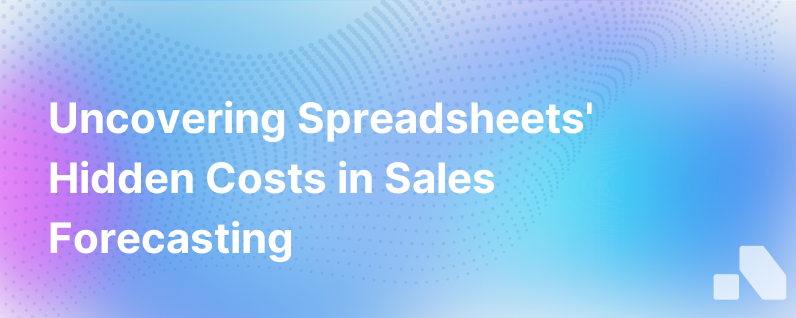The Hidden Costs Of Sales Forecasting In Spreadsheets
Published on December 17, 2023 by Sawyer Middeleer
In the dynamic business landscape, sales forecasting stands as a critical process for companies to anticipate revenue and manage resources efficiently. It involves predicting future sales based on historical data, market analysis, and numerous business drivers. For many organizations, especially small to mid-sized businesses, the go-to tool for sales forecasting has been spreadsheets. On the surface, they offer simplicity and flexibility, but beneath the veneer of convenience lie hidden costs that can hamper operational efficiency and growth. Let's dive deep into understanding the intricacies of these hidden costs and decipher how they affect businesses.
The Illusion of Efficiency
Initially, spreadsheets appear to be cost-efficient tools. Their widespread availability and the general familiarity with them mean most sales teams can start using them straight away, without the need for training or additional investment in specialized software. However, as businesses grow and sales processes become more complex, the limitations of spreadsheet-based forecasting become starkly apparent.
Time Consumption and Manual Labor
One of the most significant hidden costs is the sheer amount of manual labor involved in maintaining spreadsheets. Data entry, formula updates, version control, and error-checking are all time-consuming tasks that require significant manpower. For sales teams, every hour spent manipulating a spreadsheet is an hour not spent engaging with customers or pursuing leads. The man-hours rack up quickly, translating to higher operational costs and reduced productivity.
Furthermore, spreadsheets necessitate meticulous attention to detail. A single misplaced comma, an accidental overwrite, or a copy-paste error can throw off an entire forecast, leading to misguided strategies and decision-making.
Lack of Real-time Updates and Collaboration
In today's fast-paced market, the ability to respond to changes in real-time is a competitive advantage. Spreadsheets, however, are inherently static. They must be manually updated and shared, making it challenging to foster collaboration and ensure stakeholders are working with the most current data. Time lags in updates and the inability to simultaneously work on forecasts can lead to missed opportunities and sluggish response times.
When it comes to collaboration, version control becomes a nightmare. Multiple versions of a forecast floating around can result in confusion over which file contains the 'truth'. In contrast, modern sales forecasting tools offer live updates and centralized data, enabling seamless collaboration and ensuring that everyone is on the same page.
Scalability Constraints
As companies grow, their forecasting needs become more sophisticated. Spreadsheets are not built for scale; they become unwieldy with large data sets and complex forecasting models. They also lack the ability to integrate easily with other business systems such as Customer Relationship Management (CRM) and Enterprise Resource Planning (ERP) software. This integration is critical for accessing real-time sales data, customer interactions, and other business metrics that feed into accurate forecasts.
The lack of scalability in spreadsheets can lead to fragmented forecasting efforts, where different departments produce disparate forecasts that don't line up. A unified view of sales expectations is critical to strategic planning, resource allocation, and performance management.
Data Security and Compliance Risks
Data security is another area where the true cost of using spreadsheets for forecasting comes to light. Sensitive data contained in spreadsheets can easily become exposed, either accidentally through human error or by malicious intent through cyber-attacks. Spreadsheets often lack the robust security features that come standard with dedicated forecasting software, such as user permissions and audit trails.
Additionally, spreadsheets can become a compliance risk. In industries with strict regulatory requirements, ensuring the integrity and traceability of sales forecasting data is imperative. Failing to meet compliance can result in hefty fines and legal repercussions.
Opportunity Cost of Inaccuracies
Perhaps the most critical hidden cost is the consequence of inaccurate forecasts. Spreadsheets rely heavily on human input and subjectivity, which can lead to unintentional bias and inaccuracies. Inaccurate sales forecasts result in poor decision-making, ranging from inventory mishaps to cash flow problems. Underestimating sales can lead to stockouts and lost revenue, while overestimating can tie up capital in unsold inventory and increased holding costs.
An inaccurate forecast can dampen a company's strategic initiatives, affecting investments in marketing, R&D, hiring, and expansion plans. The long-term opportunity cost of these misalignments can be substantial and can impede a company's overall growth trajectory.
Embracing Advanced Solutions
Leveraging technology, AI-powered sales forecasting tools like Aomni work to address the challenges posed by spreadsheet-based forecasting. Systems like Aomni synthesize vast quantities of data, adjust for market trends in real-time, and provide actionable insights, thereby reducing the dependence on manual intervention. The investment in such tools not only improves forecasting accuracy but also frees up the sales team to focus on their core job: selling.
Conclusion
The hidden costs of sales forecasting in spreadsheets can be significant — from the tangible costs of labor and poor resource allocation to the intangible costs of lost opportunities and competitive edge. As businesses grow, recognizing these costs is the first step in transitioning to more sophisticated, secure, and scalable forecasting platforms that can provide a reliable foundation for data-driven decision-making and strategic growth.